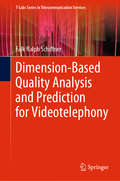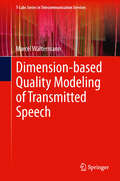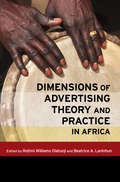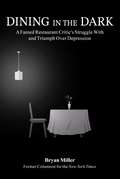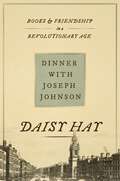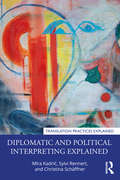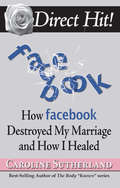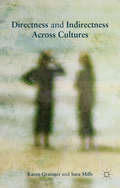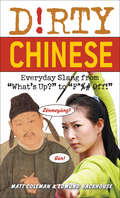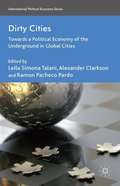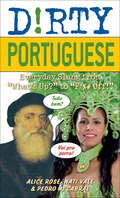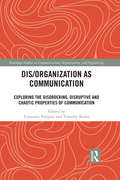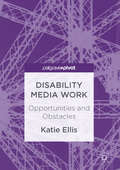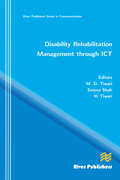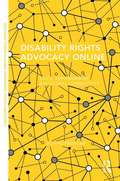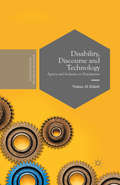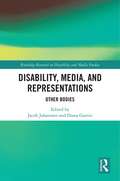- Table View
- List View
Dimension-Based Quality Analysis and Prediction for Videotelephony (T-Labs Series in Telecommunication Services)
by Falk Ralph SchiffnerThis book provides an in-depth investigation of the quality relevant perceptual video space in the domain of videotelephony. The author presents an extensive investigation and quality modeling of the underlying video quality dimensions and the overall quality. The author examines the underlying quality dimensions and describes a method for subjective evaluation as well as the instrumental estimation of video quality in videotelephony. The book presents a new subjective test method in the field of video quality assessment. Further, it explains the experimental examination of the underlying video quality dimensions and the subjective-based, as well as instrumental-based quality estimation.Provides an investigation of the underlying quality dimensions of video in videotelephony;Presents insights into a new subjective test method, standardized as ITU-T Rec. P.918;Includes insights into the subjective and instrumental video quality estimation.
Dimension-based Quality Modeling of Transmitted Speech
by Marcel WältermannIn this book, speech transmission quality is modeled on the basis of perceptual dimensions. The author identifies those dimensions that are relevant for today's public-switched and packet-based telecommunication systems, regarding the complete transmission path from the mouth of the speaker to the ear of the listener. Both narrowband (300-3400 Hz) as well as wideband (50-7000 Hz) speech transmission is taken into account. A new analytical assessment method is presented that allows the dimensions to be rated by non-expert listeners in a direct way. Due to the efficiency of the test method, a relatively large number of stimuli can be assessed in auditory tests. The test method is applied in two auditory experiments. The book gives the evidence that this test method provides meaningful and reliable results. The resulting dimension scores together with respective overall quality ratings form the basis for a new parametric model for the quality estimation of transmitted speech based on the perceptual dimensions. In a two-step model approach, instrumental dimension models estimate dimension impairment factors in a first step. The resulting dimension estimates are combined by a Euclidean integration function in a second step in order to provide an estimate of the total impairment.
Dimensions of Advertising Theory and Practice in Africa
by Ganiyu Olalekan Akashoro Sibongile Sindane Gilbert Motsaathebe Sydney Friendly Kankuzi Rotimi Williams Olatunji Shaibu Husseini Mariska Bertram Jacinta Mwende Maweu Sunday Adekunle Akinjogbin Nelson Okorie Chinenye Nwabueze Julius Abioye Adeyemo Beatrice Adeyinka Laninhun Nnamdi Tobechukwu Ekeanyanwu Assay Benjamin Enahoro Olujimi Kayode Seyi Soremekun Olayinka Egbokhare Angelique Van Niekerk Noeem Taiwo Thannyhis book brings together cutting-edge research by leading African communication and media theorists to provide a broad but detailed survey of the history and present state of the art of advertising in Africa. The book is a thought-provoking reminder of the variety of approaches to the study of marketing communication on a continent where advertising is often taken for granted. From indigenous African forms of advertising - by street criers, wall paintings, and even olfactory appeals - to the latest experiments in integrated marketing communication via the Internet, home videos, smartphones, and social media, Dimensions of Advertising Theory and Practice in Africa is a comprehensive survey both of Africa's contributions to the globalized advertising industry and of the industry's profound affect on African economies and cultures. The first collection of its kind, the book marks an important moment in the study of marketing communication in Africa. It will be an essential text for years to come.
Dining in the Dark: A Famed Restaurant Critic's Struggle with and Triumph over Depression
by Bryan MillerThe Rise and Fall of the World&’s Most Powerful Restaurant Critic and His Battle with Severe, Debilitating Depression From the early 1980s to the mid-1990s, Bryan Miller was a household name among restaurant goers in the greater New York City area and beyond as the restaurant critic for the New York Times, as well as the author of numerous books, a public speaker, and a radio and television commentator. Over ten years as a columnist, he dined out more than five thousand times in the United States and abroad, from haute to humble. The Wine Spectator, in a front-page profile, declared Miller &“the most powerful restaurant critic in America.&” And for much of that time, he wanted to die.Dining in the Dark chronicles Miller&’s battle with Bipolar II disorder, also known as depression, which ruined his life, professionally and personally. Depression was directly responsible for his surrendering the New York Times restaurant column and, shortly thereafter, leaving the paper altogether. Everything he had worked for so diligently, rising from cub reporter to big-city columnist in less than a decade, vanished. In the ensuing years, unable to work, he lost his home, his life savings, two wonderful wives, the chance to have a family, and numerous friends and colleagues. He became increasingly reclusive; like many victims of serious depression, he reached the point where he was afraid to answer the phone. Pile on a brain tumor, electroshock therapy, a near-fatal bout with Lyme disease, accidental drug overdoses (he was once carried out of the newsroom on a gurney), and you have a life in shambles.Dining in the Dark tells the story of Miller&’s battle, but it also brings hope by sharing his journey to coping with, and finally conquering, his depression. The coping mechanisms he employed in order to get through the day will be of benefit to those in need of a helping hand. Dining in the Dark is philosophical, inspirational, educational, and even humorous at times. And, of course, there are lots of inside-the-New York Times anecdotes, as well as lots of food, wine, travel, and celebrity.
Dinner with Joseph Johnson: Books and Friendship in a Revolutionary Age
by Daisy HayA fascinating portrait of a radical age through the writers associated with a London publisher and bookseller—from William Wordsworth and Mary Wollstonecraft to Benjamin FranklinOnce a week, in late eighteenth-century London, writers of contrasting politics and personalities gathered around a dining table. The veal and boiled vegetables may have been unappetising but the company was convivial and the conversation brilliant and unpredictable. The host was Joseph Johnson, publisher and bookseller: a man at the heart of literary life. In this book, Daisy Hay paints a remarkable portrait of a revolutionary age through the connected stories of the men and women who wrote it into being, and whose ideas still influence us today.Johnson’s years as a publisher, 1760 to 1809, witnessed profound political, social, cultural and religious changes—from the American and French revolutions to birth of the Romantic age—and many of his dinner guests and authors were at the center of events. The shifting constellation of extraordinary people at Johnson’s table included William Blake, William Wordsworth, Samuel Taylor Coleridge, Benjamin Franklin, the scientist Joseph Priestly and the Swiss artist Henry Fuseli, as well as a group of extraordinary women—Mary Wollstonecraft, the novelist Maria Edgeworth, and the poet Anna Barbauld. These figures pioneered revolutions in science and medicine, proclaimed the rights of women and children and charted the evolution of Britain’s relationship with America and Europe. As external forces conspired to silence their voices, Johnson made them heard by continuing to publish them, just as his table gave them refuge.A rich work of biography and cultural history, Dinner with Joseph Johnson is an entertaining and enlightening story of a group of people who left an indelible mark on the modern age.
Diplomacy, Organisations and Citizens: A European Communication Perspective
by Sónia Pedro Sebastião Susana de Carvalho SpínolaThis book uses an innovative interdisciplinary approach to explain how communication is a necessary condition for diplomacy in a digital and relationship-driven world. Divided into three parts, it highlights the importance of communication strategies and processes in contemporary society and in current global socio-political events in general, particularly within the field of diplomacy. The first part discusses the main theoretical debates that shaped the central concepts of the project, while the second part of the book presents further practical approaches and examples of diplomatic practice. Lastly, the third part focuses on pedagogical and methodological approaches, which can be useful in diplomacy and communication classes and for the implementation of a European curriculum. This interdisciplinary book will appeal to students, researchers, policy-makers, and practitioners from various disciplines, including international relations, political science, business, and communication.
Diplomatic and Political Interpreting Explained (Translation Practices Explained)
by Mira Kadrić Sylvi Rennert Christina SchäffnerThe role of the interpreter at international meetings of politicians and diplomats is a critical one. This book examines the history of diplomacy and diplomatic interpreting as well as the rules and realities of modern diplomatic relations. Building on interviews with interpreters, diplomats and politicians, it examines language as a tool of diplomatic and political communication, the role of interpreters in diplomacy, and the different forms of interaction and communicative behaviour interpreters face and exhibit. The book covers the different ways in which interpreters manage information, expressivity, and interaction, and what diplomats think about it. Each chapter presents key concepts and definitions; examples from existing literature are combined with interviews conducted with professional interpreters as well as seasoned diplomats and politicians to illustrate their relevance in interpreting practice. With activities for group work and self-study, including analysis and discussion of real-life interpreted diplomatic or political events, this book offers a range of interpreting exercises that encourage students to apply the different strategies discussed in the book. Weaving together the voices of interpreters, diplomats, and politicians with a systematic look at the theory and practice of interpreting in diplomatic settings, this is not only an essential textbook for interpreting students and educators but will also be of interest to professional interpreters and students and scholars of politics and international relations. Additional resources are available on the Routledge Translation Studies Portal: http://routledgetranslationstudiesportal.com
Direct Hit!
by Caroline Margaret SutherlandShe's a well-known author. He's a handsome, educated medical professional. How does a storybook romance turn into a Facebook nightmare of shattered trust, defamation, and even identity theft?Direct Hit! How Facebook Destroyed My Marriage and How I Healed is a harrowing account of what can and does happen on Facebook and other social media sites with alarming regularity. When Caroline Sutherland made the shocking discovery that her husband was romancing other women on Facebook-using her online profile-she didn't know that that was just the tip of the iceberg. In this riveting exposé, she charts the steps she took to uncover his criminal activities online and the legal channels she followed to seek justice.As inspiring as it is page-turning, this book is a wake-up call for readers who wonder what their spouses are really doing on the Internet. Sutherland offers straight talk about the uses and misuses of social media, practical ways for families to stay safe on Facebook, and the spiritual wisdom that can lead to healing after a betrayal of epic proportions.
Directness and Indirectness Across Cultures
by Sara Mills Karen GraingerThis book analyses the complex relationship between directness, indirectness, politeness and impoliteness. Definitions of directness and indirectness are discussed and problematised from a discursive theoretical perspective.
Dirty Chinese: Everyday Slang from "What's Up?" to "F*%# Off!" (Dirty Everyday Slang)
by Matt Coleman Edmund BackhouseFoul your mouth—while expanding your Mandarin vocabulary—with a guide to the phrases that could get you a laugh . . . or a punch in the face.Next time you’re traveling or just chattin’ in Chinese with your friends, drop the textbook formality and bust out with expressions they never teach you in school, including:Cool slangFunny insultsExplicit sex termsRaw swear wordsDirty Chinese teaches the casual expressions heard every day on the streets of China:What’s up? Zenmeyàng?Fuck it, let’s party. Qù tama, zánmen chuqù feng ba.Who farted? Shéi fàng de pì?Wanna try doggy-style? Yàobù zánliar shìshì gou cào shì?Son of a bitch! Gouniángyang de!I’m getting smashed. Wo ganjué heduo le.I can’t eat this shit! Wo chi bù xià qù!
Dirty Cities
by Alexander Clarkson Leila Simona Talani Ramon Pacheco PardoOver the last three decades, the rapid growth of transport and telecommunications systems and the expansion of transnational diasporas have intensified links between the urban spaces of Europe, Africa, the Middle East and Southeast Asia. Increasing global mobility has fostered the development of 'informal' trading networks in which diaspora communities play a central role. As a consequence, the shadow economies of societies with vastly different levels of prosperity have begun to come into contact with one another. While the economic consequences of diaspora trading networks have been extensively explored over the past few decades, the impact of globalization on the economic underground has received much less attention. This volume elaborates on the definition of globalization, on its impact on illegal and illicit activities, and on the role of the 'Global City' as the intersection between the local and the global which allows for the empowerment of generally marginalized actors often through technological progress. The contributors explore the dark side of globalization, more specifically, the relations between globalization and the new dynamics of legal/illegal practices in urban settings of global cities.
Dirty Hearts: The History of Shindō Renmei (Historical and Cultural Interconnections between Latin America and Asia)
by Fernando MoraisFernando Morais’ Dirty Hearts is a tour de force of literary journalism that investigates the discriminatory treatment of the Japanese immigrant community in Brazil during World War II and in the aftermath of Japan’s defeat and unconditional surrender. In contrast to the internment camps and compulsory military service that characterized the Japanese American wartime experience, this book traces the rise to power of Shindō Renmei, an ultranationalist secret society that formed in response to the anti-Japanese measures enacted under Getulio Vargas’ Estado Novo. Based in São Paulo, the group used terrorism, propaganda campaigns, and conspiracy theories to violently enforce its narrative of Japan’s victory. These traumatic events nevertheless brought about a permanent transformation in the Japanese Brazilian community from a largely insular colony with close ties to its imperial homeland to its new identity as an ethnic minority in postwar Brazil’s fraught racial democracy.
Dirty Japanese: Everyday Slang from "What's Up?" to "F*%# Off!" (Dirty Everyday Slang)
by Matt FargoLearn cool slang, funny insults and all the words they didn’t teach you in class with this comprehensive guide to dirty Japanese.You’ve taken Japanese lessons and learned all kinds of useful phrases. You know how to order dinner, get directions, and ask for the bathroom. But what happens when it’s time to drop the textbook formality? To really know a language, you need to know it’s bad words, too. You need Dirty Japanese.From common slang and insulting curses to explicit sexual expressions, this volume teaches the kind of Japanese heard heard every day on the streets from Tokyo to Kyoto from “What’s up?” (Ossu?) to “I’m smashed,” (Beron beron ni nattekita.).
Dirty John and Other True Stories of Outlaws and Outsiders
by Christopher GoffardA collection of newspaper stories by award-winning Los Angeles Times reporter Christopher Goffard—including &“Dirty John,&” the basis for the hit podcast and the upcoming Bravo scripted series starring Connie Britton and Eric Bana.Since its release in fall 2017, the &“Dirty John&” podcast—about a conman who terrorizes a Southern California family—has been downloaded more than 20 million times, and will soon premiere as a scripted drama on Bravo starring Connie Britton and Eric Bana. The story, which also ran as a print series in the Los Angeles Times, wasn&’t unfamiliar terrain to its writer, Christopher Goffard. Over two decades at newspapers from Florida to California, Goffard has reported probingly on the shadowy, unseen corners of society. This book gathers together for the first time &“Dirty John&” and the rest of his very best work. &“The $40 Lawyer&” provides an inside account of a young public defender&’s rookie year in the legal trenches. &“Framed&” offers an unblinking chronicle of suburban mayhem (and is currently being developed by Netflix as a film starring Julia Roberts). A man wrongly imprisoned for rape, train-riding runaways in love, a Syrian mother forced to leave her children in order to save them, a boy who grows up to become a cop as a way of honoring his murdered sister, another boy who struggles with the knowledge that his father is on death row: these stories reveal the complexities of human nature, showing people at both their most courageous and their most flawed. Goffard shared in the Los Angeles Times&’ Pulitzer Prize for Public Service in 2011 and has twice been a Pulitzer finalist for feature writing. This collection—a must-read for fans of both true-crime and first-rate narrative nonfiction—underscores his reputation as one of today&’s most original journalistic voices.
Dirty Portuguese: Everyday Slang from "What's Up?" to "F*%# Off!" (Dirty Everyday Slang)
by Pedro A Cabral Alice Rose Nati ValeLearn cool slang, funny insults and all the words they didn’t teach you in class with this comprehensive guide to dirty Portuguese.You’ve taken Portuguese lessons and learned all kinds of useful phrases. You know how to order dinner, get directions, and ask for the bathroom. But what happens when it’s time to drop the textbook formality? To really know a language, you need to know its bad words, too. You need Dirty Portuguese.From common slang and insulting curses to explicit sexual expressions, this volume teaches the kind of Portuguese heard every day on the streets of Brazil. Learn to sound like a native speaker with phrases like:What’s up? — Tudo bem?Are those fake boobs? — Você tem silicone no peito?I need to take a piss. — Preciso mijar.That goalie is so weak. — Esse goleiro é uma mãe.Shit’s about to go down! — O coro vai comer!I’m smashed. — Tô bebum.Let’s fuck like animals. — Vamos trepar como animais.
Dirty Spanish Flash Cards: Everyday Slang From "What's Up?" to "F*%# Off!" (Dirty Everyday Slang)
by Juan CaballeroQuickly memorize the dirty words and off-color expressions not taught in any Spanish class. Flashcards aren’t just for developing an SAT vocabulary. With Dirty Spanish Flashcards, readers can quickly master the bawdy Spanish terms never seen in a textbook. From casual greetings and cutting put-downs to explicit sex terms and filthy swear words, each flashcard presents a hip vocabulary word and example sentence on one side and an English definition on the reverse. It’s a fun and fast way to learn the real Spanish spoken daily on the streets of Latin America and Spain. This deck is designed for readers to master Spanish and engage people in a foreign language on an entirely new level. With phrases like “I’m plastered!” and “Let’s hit the clubs!”, readers will be making new friends in no time. In addition to pickup lines and insults, the deck contains other contemporary slang like globos, literally “globes” but which can also refer to a woman’s personal endowments; or malparido, which means “badly born,” but can be used to call someone an a**hole.Featuring:• Cool slang• Funny insults• Explicit sex terms• Raw swear words
Dirty Spanish: Everyday Slang from "What's Up?" to "F*%# Off!" (Dirty Everyday Slang)
by Juan CaballeroLearn how to swear like a native speaker with this highly improper phrasebook! Learn the slang words, modern phrases, and curses they never taught you in Spanish class with this hilariously improper English-Spanish phrasebook. You already know enough Spanish to get by, but you want to be able to tell those inside jokes, greet your friends in a laid-back manner, and casually pick someone up at a bar. From &“What&’s up?&” to &“Wanna go home with me?&” Dirty Spanish will teach you how to speak like you&’re a regular on the streets of Madrid or Mexico City or Buenos Aires. But you&’ll also discover material that goes beyond a traditional phrasebook, including: *Hilarious insults *Provocative facts *Explicit swear words *Themed Spanish cocktails *and more! Next time you&’re traveling to Spain, Mexico, or South America—or just practicing your conversational Spanish—drop the textbook formality, and get dirty!
Dirty Wars and Polished Silver: The Life and Times of a War Correspondent Turned Ambassatrix
by Lynda SchusterFrom a former Wall Street Journal foreign correspondent, an exuberant memoir of life, love, and transformation on the frontlines of conflicts around the worldGrowing up in 1970s Detroit, Lynda Schuster felt certain life was happening elsewhere. And as soon as she graduated from high school, she set out to find it. Dirty Wars and Polished Silver is Schuster’s story of her life abroad as a foreign correspondent in war-torn countries, and, later, as the wife of a U.S. Ambassador. It chronicles her time working on a kibbutz in Israel, reporting on uprisings in Central America and a financial crisis in Mexico, dodging rocket fire in Lebanon, and grieving the loss of her first husband, a fellow reporter, who was killed only ten months after their wedding.But even after her second marriage, to a U.S. diplomat, all the black-tie parties and personal staff and genteel “Ambassatrix School” grooming in the world could not protect her from the violence of war.Equal parts gripping and charming, Dirty Wars and Polished Silver is a story about one woman’s quest for self-discovery—only to find herself, unexpectedly, more or less back where she started: wiser, saner, more resolved. And with all her limbs intact.
Dirty Yiddish: Everyday Slang from "What's Up?" to "F*%# Off!" (Dirty Everyday Slang)
by Adrienne GusoffNext time you’re chattin’ with your khaverim (friends) and mishpukheh (family), bust out some Yiddish expressions that’ll liven up the conversation.Nothing is censored in Dirty Yiddish. It includes phrases for any situation, so readers have enough chutzpah (balls) to tell the local deli that they’ve waited long enough for their knish, and explicit swear words crude enough to shock Bubby and everyone else at the Passover seder. There’s even vulgar sex terminology so graphic it puts the outspoken Lower East Side princesses to shame. Bust out with expressions they never teach you in school, including cool slang, funny insults, explicit sex terms, and raw swear words. Dirty Yiddish teaches the casual expressions heard every day on the streets of New York . . . What’s up? Vos makhst du?Crazy bastard! Meshuggeneh momzer!I’m hammered. Ikh bin fershikkert.Don’t fuck with me! Bareh mikh nit!I have the shits. Ikh hob a shittern mogn.Lick my pussy. Lekh meyn lokh.Was it good for you? Tsufreedn?
Dis/organization as Communication: Exploring the Disordering, Disruptive and Chaotic Properties of Communication (Routledge Studies in Communication, Organization, and Organizing)
by Consuelo Vásquez Timothy KuhnThis book accounts for the transformation of organizations in a post-bureaucratic era by bringing a communicational lens to the ontological discussion on organization/disorganization, offering a conceptual and methodological toolbox for studying dis/organization as communication. Increasingly, scholars acknowledge that communication is constitutive of organization; because meaning is always indeterminate, communication also (and simultaneously) generates disorganization. The book synthesizes the major theoretical trends and empirical studies in communication that engage with dis/organization. Drawing on dialectics, relational ontologies, critical theory, systems theory, and affect thinking, the first part of the book offers communicational explanations of how dis/organization unfolds. The second part of the book grounds this theoretical reflection, providing empirical studies that mobilize diverse methodological and analytical frameworks (e.g., ethnography, situational, interactional and genre analysis) for studying the practices of dis/organization. Overall, the book exposes organizations (and organizing processes) as significantly messier, irrational (or a-rational), and paradoxical than scholars of organization typically think. It also offers readers the conceptual and methodological tools to understand these complex processes as communication. This book will be essential reading for scholars in organizational communication or management and organization studies, together with senior undergraduate and graduate students studying organizational communication, organizational discourse, discourse analysis (including rhetoric, semiotics, pragmatism, narratology) and courses in management studies. It will also be richly rewarding for organizational consultants, managers and executives.
Disability Media Work
by Katie EllisThis book interrogates trends in training and employment of people with disabilities in the media through an analysis of people with disabilities' self-representation in media employment. Improving disability representations in the media is vital to improving the social position of people with disability, and including people with lived experience of disability is integral to this process. While the media industry has changed significantly as a result of digital and participatory media, discriminatory attitudes around fear and pity continue to impact whether people with disability find work in the media. The book demonstrates no significant changes in attitudes towards employing disabled media workers since the 1990s when the last major research into this topic took place. By focusing on the employment of people with disability in media industries, Katie Ellis addresses a neglected area of media diversity, appealing to researchers in media and cultural studies as well as critical disability studies.
Disability Rehabilitation Management Through ICT
by M. D. Tiwari Iti Tiwari Seema ShahThis is the fifth publication under the IIIT-A Series on e-Governance. It is a collection of 20 articles based on the presentations made in the Seminars. This book will of interest to all stakeholders in the disability rehabilitation management as the population of people with disabilities in growing.
Disability Rights Advocacy Online: Voice, Empowerment and Global Connectivity (Routledge Studies in Global Information, Politics and Society)
by Filippo TrevisanDisability rights advocates in the United Kingdom and the United States recently embraced new media technologies in unexpected and innovative ways. This book sheds light on this process of renewal and asks whether the digitalisation of disability rights advocacy can help re-configure political participation into a more inclusive experience for disabled Internet users, enhancing their stakes in democratic citizenship.
Disability, Discourse and Technology: Agency and Inclusion in (Inter)action (Postdisciplinary Studies in Discourse)
by Najma Al ZidjalyExclusion is the main predicament faced by people with disabilities across contexts and cultures, yet it is one of the least academically studied concepts. This book offers an applied linguistics perspective on critical and timely issues in disability research, filling in a number of gaps in discourse analysis and disability studies.
Disability, Media, and Representations: Other Bodies (Routledge Research in Disability and Media Studies)
by Jacob Johanssen Diana GarrisiBringing together scholars from around the world to research the intersection between media and disability, this edited collection aims to offer an interdisciplinary exploration and critique of print, broadcast and online representations of physical and mental impairments.Drawing on a wide range of case studies addressing how people can be ‘othered’ in contemporary media, the chapters focus on analyses of hateful discourses about disability on Reddit, news coverage of disability and education, media access of individuals with disabilities, the logic of memes and brain tumour on Twitter, celebrity and Down Syndrome on Instagram, disability in TV drama, the metaphor of disability for the nation; as well as an autoethnography of treatment of breast cancer. Providing a much-needed global perspective, Disability, Media, and Representations examines the relationship between self-representation and representations in either reinforcing or debunking myths around disability, and ways in which academic discourse can be differently articulated to study the relationship between media and disability. This book will be of interest to students and researchers of disability studies and media studies as well as activists and readers engaged in debates on diversity, inclusivity and the media.
